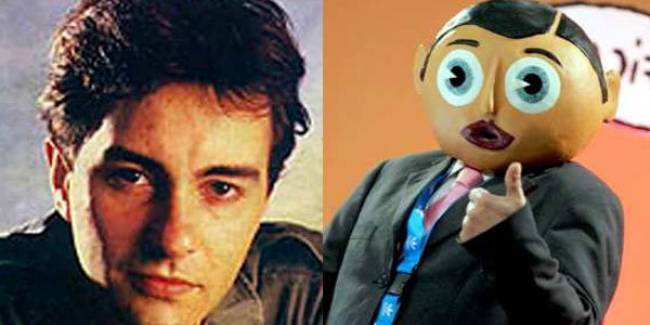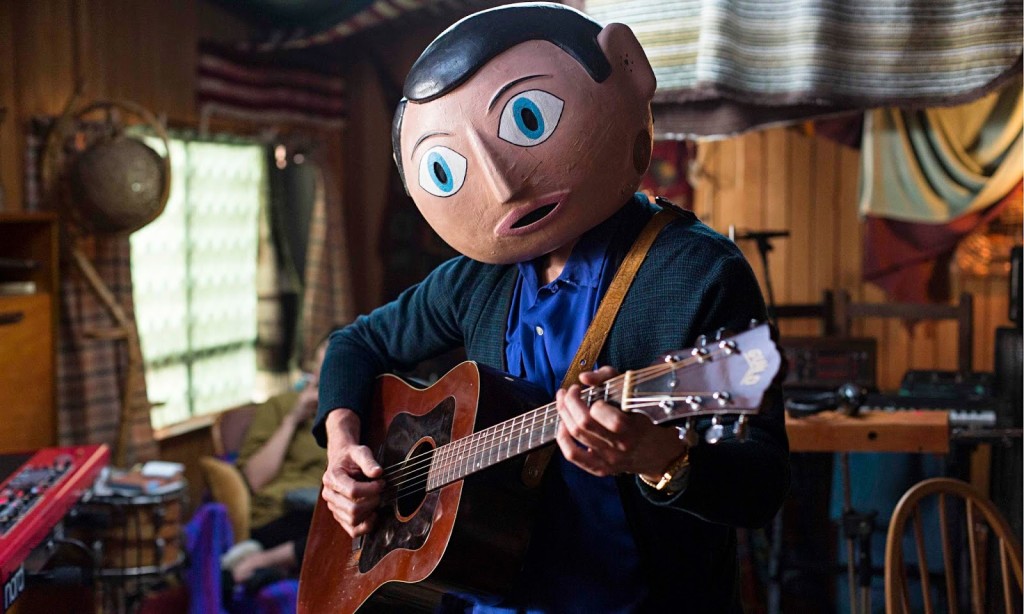Reviews include The Wedding Banquet, The Courageous, and It Feeds.
It’s Not A Documentary: Frank Sidebottom and the film inspired by his life
August 28, 2014
By: Jim Slotek
Disclosure: As I was writing this, I had not seen the Lenny Abrahamson’s movie Frank. I suspect I’ll enjoy it, notwithstanding the thoughts expressed below.
Chris Sievey, also known as his stagename Frank Sidebottom.
In 1986, I was part of two couples visiting London for the first time. My friend Mark and I were fans of Boston man-child singer-songwriter Jonathan Richman, who was playing a venue in Kentish Town called “The Town & Country.” A lounge, we figured. Instead, it turned out to be a licensed hall holding more than a thousand people – all of whom knew all of Richman’s lyrics, including, weirdly, a song about baseball (Walter Johnson).
But we discovered something else about live club music in England: the caliber of the opening acts. There were three, all strong, including some Celtic locals, Sierra Leone folksinger Soolimon Rogie (since deceased) and one of the strangest acts we’d ever seen:
Frank Sidebottom.

Frank came out in formal attire, wearing a gigantic papier-mâché head that looked uncannily like Davy from the Jesus-themed stop-motion kids’ series Davy & Goliath. Ukulele in hand, he played what seemed like campy music-hall versions of chart hits–including “Every Breath You Take,” replacing all the stalker-darkness in that song with deranged merriment.
Locals told us that, yes, Frankie Sidebottom was a local celebrity, who’d had occasional British chart hits. What an eccentric country.
Back home, in a pre-Google world, it was hard to keep track of this strange apparition. Over the next few years, I read articles about him in NME and Spin magazine. Turns out he was a punk rocker who’d reinvented himself under that concoction of paste and shredded paper as a creature of whimsy–a natural fit with Richman, who’d also let go of his early punk persona with both hands in favour of children’s songs for adults. Sidebottom would go on to host a cultish British TV series and write episodes of the children’s series Pingu.
Flash forward to the 21st Century. In the past year, Mark and I–still great friends–were excited to hear about Frank, a movie in which Michael Fassbender would play a musician who performed in, yes, a papier-mâché boy’s head (which he wore in daily life as well).
Early U.K. press reports said the character was “based on” Sidebottom. Later, as the film came closer to completion, they began using the words “inspired by.”

Frank premiered at Sundance to generally favourable reviews (90% on Rotten Tomatoes). Fassbender was on The Colbert Report where he played with his movie-band, including Maggie Gyllenhaal on keyboards. The sound was minimalist alt-rock, pretty entertaining stuff from a bunch of actors.
In his interview with Colbert, Fassbender talked about the challenge of filming an entire movie while wearing the giant head. Sidebottom was never mentioned.
I was left with mixed feelings, beyond the disappointment of not actually seeing Sidebottom’s story as a movie. But as has been pointed out to me a hundred times by directors, writers, and producers, Frank is “not a documentary.” (My favourite variation on that theme came from the producer of an NBC miniseries about Mussolini, starring George C. Scott. “Reality is the enemy of art.”)
Still, the reality is that writer Jon Ronson (The Men Who Stare At Goats)–a sometime member of Sidebottom’s own band–knew his subject well. In the end, however, he apparently cherry-picked only Sidebottom’s first name and central gimmick. He fictionalized a new story (embracing stuff from the lives of Captain Beefheart and Daniel Johnston) to support a pet metaphor about “outsider art,” and ambition versus talent.
His defense has been that Sidebottom seemed unaware of his pathologies, and it would have hurt his feelings to portray him honestly. Fair enough, but he did write a presumably-honest book about his time with him. But Sidebottom–Chris Sievey–died in 2010 during the movie’s preproduction, with the knowledge that Ronson’s movie was more or less “about” him anyway. And he might infer by the fictionalizing, that minus his stage prop, his real, soon-to-be-over life was of no filmic interest.
Writing about real people or subjects can be problematic. They can be revealed after-the-fact to have some unsightly warts, like A Beautiful Mind’s John Nash, or The Hurricane’s Rubin Carter. Whole towns can end up hating you–like the town of Gloucester, Mass., which collectively despises the movie The Perfect Storm.
And yes, all stories originate from somewhere and someone real. If you are Joel and Ethan Coen, you tease people with references to Ulysses or “actual” woodchipper-murders that are impossible to verify. If the subject is hundreds of years dead, like Amadeus’s Salieri, you can character-assassinate at will.
But what is your responsibility when your inspiration is real, alive and publicly known?
In a way, writers are vampires. In the 1990s, I was hired to write a first draft of a script about a Native activist in North Carolina who’d held a small-town newspaper hostage while demanding investigations into suspicious deaths of minorities. We changed his name and made up conversations and events. I met him at his prison, where he registered disapproval over the name change. Still, there was interest from some sort-of “name” actors, who professed to like the script.
I’m actually glad the movie was never made. I would have had to face people whose court testimony I’d used verbatim, and around whom I’d created fake characters. They were ordinary people who happened to have once had a gun pointed at them and who didn’t ask to be fictionalized.
Frank Sidebottom was definitely not ordinary. But he wasn’t a powerful show business personality. He was a cult entertainer with offstage drug and alcohol problems–a “sad clown,” as it were.
I don’t know if a movie script could catch the glint of odd magic we saw that day in Kentish Town. I do know that – its non-documentary status notwithstanding–a feature film tends to become the de facto “record” of someone’s life. And, for our purposes, Sidebottom’s record now reads, “He partly inspired Michael Fassbender’s character in Frank… YOU know, the one where he wore a giant papier-mâché head?”
If Sidebottom were more famous? Imagine a movie called Ray about a blind musician, where the music wasn’t R&B and the story was changed to ostensibly obscure its source.
Postscript: this year will in fact see the release of a documentary, Being Frank. I intend to see it, though I doubt it will get much play on this side of the ocean, much less get plugged on The Colbert Report.



